Operator Dies From Crushing Injuries After Being Pinned Between a Track Drill Control Console and Exterior Wall of Courthouse - Tennessee
NIOSH In-house FACE Report 2005-09
February 12,2007
Summary
On June 15, 2005, a 58-year-old track drill operator (the victim) was killed when he was pinned and crushed between the control console of a track drill and the exterior wall of a courthouse. While standing between the drill control console and the exterior wall, the victim drilled four holes into the ground. While attempting to drill the fifth hole, it appears that the victim inadvertently activated the controls causing the boom to extend and pin him between the control console and the wall.
Hearing the engine of the track drill racing, a laborer found the victim unconscious and pinned against the wall. The laborer ran to get a track hoe operator for assistance. After arriving back at the track drill, the track hoe operator and the laborer ran to get another track hoe operator who knew how to operate the track drill. The first track hoe operator then ran to notify the foreman, while the second track hoe operator backed the track drill off of the victim. The foreman called 911 and then checked the victim.
Approximately 3 minutes later, Emergency Medical Services (EMS) responded and determined that the victim’s chest had been crushed and he was not breathing. The victim was transported by ambulance to an area hospital where he was pronounced dead.
NIOSH investigators concluded that, to help prevent similar occurrences, employers should:
- ensure equipment operators properly use the equipment they are assigned to operate including making operators aware of potential “pinch points”
- develop a pre-job safety plan for the work site which includes hazard recognition and avoidance of unsafe conditions, and ensure that it is implemented and reviewed with workers prior to each day’s work
Additionally, equipment designers and manufacturers should:
- consider adding equipment control guards to prevent the inadvertent operation of equipment controls
- consider including an interlock device (panic bar) to automatically shut down energy when pressure is applied to the protective bar on the drill control console
- consider the intended use of a machine and include appropriate safety warnings in the instruction manual as well as warning labels on the machine to address the hazard of being caught between the machine and stationary objects
Although the following recommendations may not have prevented this fatality, NIOSH concluded that as a matter of prudent safe operations, equipment designers and manufacturers should:
- consider standardizing the location of various individual controls within control panels located on the same or similar machines and increasing the size of the emergency stop buttons
Introduction
On June 15, 2005, a 58-year-old track drill operator (victim) was killed when he was pinned and crushed between the control console of a track drill and the exterior wall of a courthouse. On June 23, 2005, officials of the Tennessee Occupational Safety and Health Administration (TOSHA) notified the National Institute for Occupational Safety and Health (NIOSH), Division of Safety Research (DSR), of the incident. On September 13, 2005, a DSR safety and occupational health specialist conducted an investigation of the incident and reviewed the incident circumstances with the TOSHA investigating safety compliance officer and safety compliance manager assigned to the case. Photographs of the incident site and witness statements taken by TOSHA shortly after the incident were reviewed. The city police report, medical examiner’s report and death certificate were reviewed. On September 14, 2005, the victim’s employer’s safety consultant was interviewed and a site visit was conducted. A telephone interview was also conducted with the state service support manager representative from the track drill manufacturer.
Employer: The victim’s employer was a land and highway development company that had been in business for approximately 20 years. The company employed 450 full-time workers in the state of Tennessee. The foreman on the job site had been in his position for approximately 15 years. The company employed a foreman, three laborers, dump truck operator, two track hoe operators, and a rock drill operator (victim) on this jobsite at the time of the incident. The employer was subcontracted to perform excavation activities at the city courthouse. This was the company’s first workplace fatality.
Victim: The 58-year-old male victim had been working full-time for the company as a track drill operator for 18 years, however he had temporarily left the company twice. During his career with the employer, his only occupation was track drill operator. The victim had operated track drills for approximately thirty years. The victim had been rotating between the incident site and another jobsite on the week prior to this incident.
Written Safety Program and Training: The company had a written safety program. A new employee would attend a four-hour safety and health orientation. Weekly tool box talks were conducted by the foreman on the job site to warn of potential worksite hazards. The company’s safety program required that track drill operators demonstrate their skills in using the equipment to a supervisor before working alone. New employees were provided with additional job-specific training and were monitored and on a probationary period for 90 days.
Incident Scene: The employer was subcontracted to assist with various site preparations at the city courthouse. The area was being excavated in order to install an underground tunnel leading from a new parking structure which was being constructed adjacent to the existing courthouse. Holes were being drilled so that the ground, consisting mostly of solid rock, could be broken up with the use of a hoe ram. The holes were being drilled 16 feet into the ground. This process was being done because drilling the ground speeds up the ramming process. Located on the courthouse exterior wall in the vicinity of where the incident occurred was a wall fire hydrant mounted approximately 6 inches above the ground that extended approximately 6.5 inches outward. Following the incident, photos taken by the company’s safety consultant indicated that the victim’s hard hat and a foot print on the ground were found to be in close proximity to the wall fire hydrant. It is theorized that the victim may have tripped on the wall fire hydrant, and inadvertently activated the track drill’s control while attempting to break his fall.
Equipment: The track drill involved in this incident was a hydraulic track-mounted, self contained deck-engine-powered percussive drill, designed for construction and quarry applications (Photo 1). The track drill used a diesel engine coupled directly to a hydraulic pump, and an excavator type undercarriage. Two consoles operated the track driller; a main control console and a drill control console. The main control console was located on the side of the drill’s frame, was used to tram the drill into position, and contained all necessary start-up switches and engine monitoring gauges (Photo 2). The main control console also included a hydraulic valve bank that could be used for boom and drill guide positioning. The drill control console was mounted on, and moved with the drill boom guide, allowing optimal operator visibility of the hole collar (Photo 3 and Photo 4). The drill boom and guide featured a hydraulically driven drifter and hydraulic drill feed systems. The drill control console contained the feed and rotation controls and gauges, dust collector and water injection controls, automatic rod changer controls, emergency stop button, blow control lever and blow air pressure gauge, dust collector, and the centralizer control. The drill control console could be rotated counter clockwise sideways up to 80 degrees by removing a pin and then selecting one of the three locking slots, which allows the console to be repositioned (Photo 4). All the control levers on the track drill were self-centering.
All drilling functions were controlled from the drill control console on the boom of the drill. Drill tramminga controls were located on the main control console. The boom and guide on the track drill was designed for both vertical and angle drilling. The boom hydraulic cylinders extended, raised and lowered the boom while the dump and swing cylinders set the drilling angle. The drill control console controlled the boom and guide functions including boom swing, lift and extension. Guide extension, dump and swing could be controlled from both control consoles.
The track drill was purchased new three months prior to this incident. The setup and controls were the same as the previous drill used by the company. After the track drill was purchased, a manufacturer representative came to the employer’s site and showed the new equipment to the track driller operators.
Weather: It was daylight at the time of the incident. Conditions were early sunlight and the temperature was in the 70’s.
a Process of moving a drill from a completed hole to the next location.
Back to Top
Investigation
The track drill operator (victim), dump truck operator, two track hoe operators, and three laborers arrived on site at approximately 6:30 a.m. on the day of the incident. There were markings on the ground which indicated that two parallel rows of four holes needed to be drilled. The holes to be drilled were approximately two feet out from the exterior wall of the courthouse. The victim trammed the drill so it faced the courthouse’s exterior wall, then positioned himself with his back to the exterior wall and the drill control console in front of him. While sandwiching himself between the exterior wall and drill control console, he operated the boom drill and began drilling holes in the ground. While drilling the fourth hole, it is believed that the victim inadvertently operated the boom extension control in such a way that he pinned himself between the drill control console and the exterior wall (Photo 5).
At approximately 8:30 a.m., while walking through the work area, a laborer heard the drill engine racing, and as he approached the drill, he observed that the boom was not moving and no drilling was being done. Once at the drill, he found the unconscious victim pinned between the drill control console and the exterior wall. The laborer ran and retrieved one of the track hoe operators in the vicinity. When the track hoe operator arrived at the drill, he saw that the victim was pinned, so he and the laborer ran to find the other track hoe operator, believing that he might know how to operate the drill. Once they found the other operator, all three ran back to the drill. Seeing his co-workers running, the dump truck operator ran after them to see what had happened.
The second track hoe operator used the forward and reverse tram controls located on the main control console to reverse the machine and move it away from the wall. As the second track hoe operator attempted to move the drill off of the victim, the first operator ran to the other side of the building to notify the foreman. After the machine was backed up, the victim fell to the ground. The second operator turned off the machine and checked the victim’s vital signs.
The foreman had arrived from another jobsite and was standing on the east side of the courthouse talking with the general contractor when the first track hoe operator came running over to notify him that the victim was pinned between the wall and the track drill on the other side of the building. After the operator informed the foreman of the incident, they ran approximately 300 yards to the other side of the building. When they arrived at the drill, the second operator had already reversed the track drill and let the victim fall to the ground. At 8:35 a.m., the foreman called 911 on his mobile phone requesting medical assistance and then checked the victim.
At 8:38 a.m., Emergency Medical Services (EMS) and police arrived on the scene. EMS assessed the victim and found that his chest was crushed and he was not breathing. After not locating any vital signs, the victim was transported via ambulance to a local hospital, where he was pronounced dead at 8:48 a.m. in the emergency room.
Following this incident, the TOSHA compliance officer interviewed a track drill operator that had operated the drill within the last thirty days and the operator stated that it had worked “fine.” Additionally, a representative from the equipment manufacturer and employer’s insurance company examined the track drill at the incident site and reported to TOSHA that no mechanical deficiencies were found.
It is theorized that the victim, while attempting to drill the fifth hole, may have tripped over the wall fire hydrant and inadvertently activated the controls causing the boom to extend and pin him between the control console and the courthouse wall.
Back to Top
Cause of Death
The medical examiner’s report stated that the cause of death was crushing injuries of the chest due to blunt force trauma.
Recommendations/Discussion
Recommendation #1: Employers should ensure equipment operators properly use the equipment they are assigned to operate including making operators aware of potential “pinch points.”
Discussion: Employers should ensure that equipment operators properly use the equipment they are assigned to operate including making operators aware of potential “pinch points.” According to the track drill operator’s manual, within the operating safety precautions and guidelines, operators are required to use “EXTREME CAUTION and to be very observant when operating in close quarters or congested areas,” to KNOW the area in which they are working and to familiarize themselves with all of the work-site obstructions (e.g., the exterior wall) and any other potential hazards (e.g., a wall fire hydrant) in the area.1
Recommendation #2: Employers should develop a pre-job safety plan for the work site which includes hazard recognition and avoidance of unsafe conditions and ensure that it is implemented and reviewed with workers prior to each day’s work.
Discussion: Prior to beginning track drilling at a site, a pre-job safety plan should be developed that defines the drilling operations for the site. Employers should evaluate tasks performed by workers, identify all potential hazards, and then implement and enforce a pre-job safety plan addressing these hazards. In addition, prior to each day’s drilling, a “competent person”b should conduct a brief review of the plan and reconfirm a driller’s work area, the direction of the drilling and the positioning of the equipment while the track drill will be in operation.2 In this incident, the victim positioned himself between the exterior wall and driller’s console while drilling holes in the ground. The drill control console could have been rotated sideways up to 80 degrees, which would have allowed the driller’s console to be repositioned, therefore affording the operator more working space.
Recommendation #3: Equipment designers and manufacturers should consider adding equipment control guards to prevent the inadvertent operation of equipment controls.
Discussion: Control guards are safety features designed to prevent the inadvertent operation of equipment controls, levers, switches, buttons and similar control devices (Figure).3 Smaller controls such as switches and buttons can be covered to prevent accidentally bumping or pressing these controls. Larger controls such as levers may require bars or specially designed guards to limit access to the levers. Alternatively, mechanical stops such as removable pins or blocks can be used to limit movement of the lever until the operator is ready to activate the control(s).
In this incident, the victim was found pinned between the drill control console and the exterior wall of a courthouse. It is believed that the victim may have tripped as he was positioning the drill guide to start drilling a new hole. The victim may have reached for the control panel to catch his balance, and inadvertently pulled on the boom extension lever or the boom swing lever. Activating either lever would have moved the drill guide assembly closer to the exterior wall, pinning the victim against the wall.
Recommendation #4: Equipment designers and manufacturers should consider including an interlock device (panic bar) to automatically shut down energy when pressure is applied to the protective bar on the drill control console.
Discussion: The drill control console featured a protective bar around the lower portion of the control panel intended as a guard to keep the operator from getting too close to the drill guide assembly and also to protect the control panel. There were no interlock devices installed on the protective bar around the lower portion of the drill control panel. An interlock system is especially important in cases where a equipment operator is working in close proximity. In this case, an interlock device mounted on the protective bar and connected to the equipment’s operating controls would have automatically shut down the operation when the protective bar received a certain amount of exterior pressure. This bar could be re-designed to include a toggle switch interlocked with the emergency stop switch so that pressing against the bar would de-energize the machine. Such a re-design would produce an easy to activate “panic bar” that could be activated from any direction around the drill control console and may have been able to prevent this fatality (Photo 3 ).
Recommendation #5: Equipment manufacturers should carefully consider the intended use of a machine and include appropriate safety warnings in the instruction manual as well as warning labels on the machine to address the hazard of being caught between the machine and stationary objects.
The instruction manual provided by the manufacturer for the track drill involved in this incident contained limited warnings about operating the track drill in confined areas or close proximity to other objects.1 The machine had warning labels affixed that addressed pinch points where the operator should not place hands, arms, etc., but did not warn against the hazard of being caught between the machine and a wall, barrier or other solid object. Also, the drill control console was mounted on a bracket that afforded the ability to rotate the control panel up to 80 degrees horizontally. However, the manufacturer’s instruction manual does not make mention of this feature. The victim could have provided himself more room to work in by rotating the control panel to the right (away from the building). The state service support manager representative from the track drill manufacturer stated that the representative demonstrates the drill features for the employees at the time of purchase and during this time normally shows the rotation feature of the drill control console. The utility and importance of this feature plus the appropriate safety warnings in the instruction manual as well as warning labels on the machine should be highlighted to address the hazard of being caught between the machine and another stationary object.
Although the following recommendation may not have prevented this fatality, NIOSH concluded that as a matter of prudent safe operations,
Recommendation #6: Equipment designers and manufacturers should consider standardizing the location of various individual controls within the control panels located on the same or similar machines and increasing the size of the emergency stop buttons.
Discussion: Equipment controls should be designed and located for ease of operation by the operator. Controls, switches, and levers should be laid out in a logical manner, taking into consideration the intended purpose of the machine. For example, the main functions of an end loader or backhoe involve raising and lowering the bucket so these controls should be centrally located, with controls for functions used less often, such as stabilizer jacks, located to the side(s). In most cases, functions that operate in a specific direction, such as swinging right or left, should be activated by controls positioned to the corresponding side of the machine.
In this incident, the track-mounted rock drill had two separate control panels mounted on the machine. The main control console, mounted to the machine frame over the tracks included a platform for the operator to stand on. This control panel could be used to operate all functions of positioning the rock drill, including tramming the machine and swinging and raising the boom. The drill control console, mounted on the drill mast could only be used to control the drill functions. The main control console, where the tramming function is controlled, contained an emergency stop button located in the center of the control panel and the drill console emergency stop button was located on the far left side of the drill console (Photo 6). Placing the emergency stop buttons in the same vicinity on both consoles will assist operators with always knowing where the button is located if an emergency occurs. Additionally, increasing the size of the emergency stop button would assist in making the button more readily accessible for use in difficult times and conditions.
b “Competent person” means one who is capable of identifying existing and predictable hazards in the surroundings or working conditions which are unsanitary, hazardous, or dangerous to employees, and who has authorization to take prompt corrective measures to eliminate them.
Back to Top
References
- Manufacturer’s Operator’s Manual. 2005.
- Code of Federal Regulations 2006 edition. 29 CFR 1926.32(f). General Safety and Health Provisions. U.S. Printing Office, Office of the Federal Register, Washington, D.C.
- Anonymous. Incident Bulletin 2004 NOA 174. Worker Fatality: Operator Crushed by Scissor Lift. Vancouver, BC: Workers’ Compensation Board of British Columbia.
Back to Top
Investigator Information
This investigation was conducted by Nancy T. Romano, Safety and Occupational Health Specialist, Fatality Investigations Team, Surveillance and Field Investigations Branch, Division of Safety Research.
Acknowledgement
The NIOSH FACE Program and the safety and occupational health specialist would like to acknowledge the Compliance Officer, Safety Compliance Manager, Manager of Standards and Procedures, and staff of the Tennessee Department of Labor and Workforce Development, Division of Occupational Safety and Health (TOSHA) program; and Timothy R. Merinar, Safety Engineer, Division of Safety Research, Morgantown, WV for their assistance in this investigation.
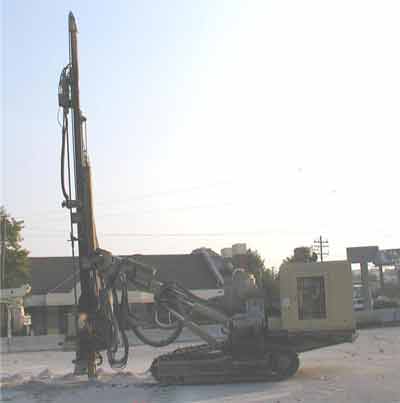 |
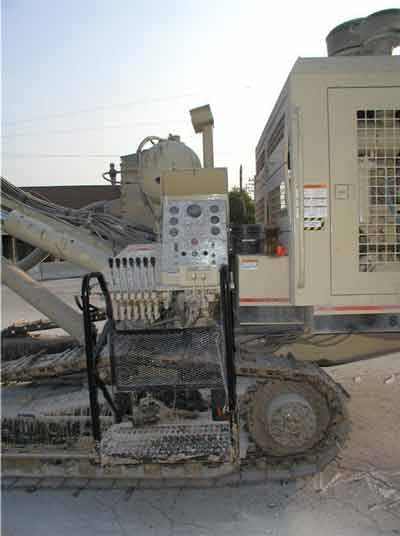 |
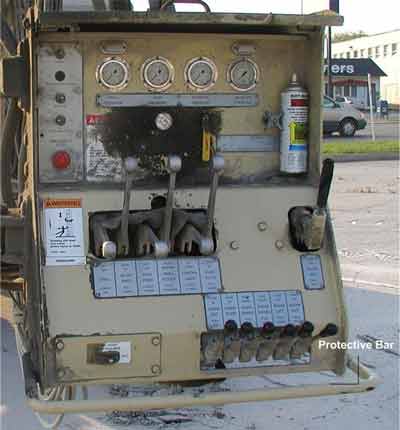 |
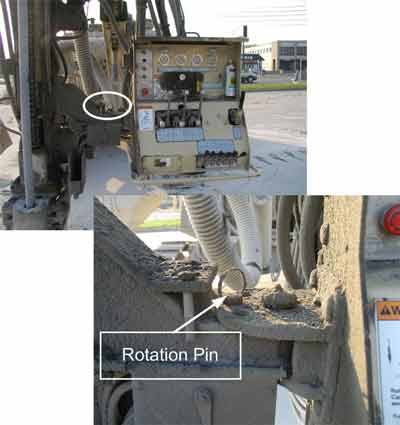 |
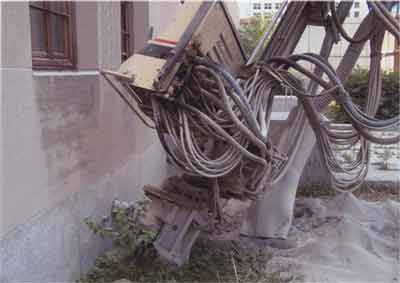 |
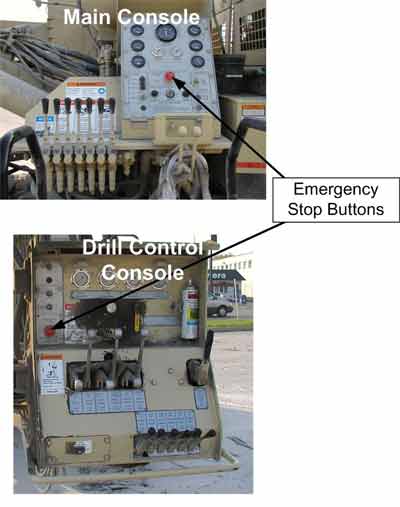 |
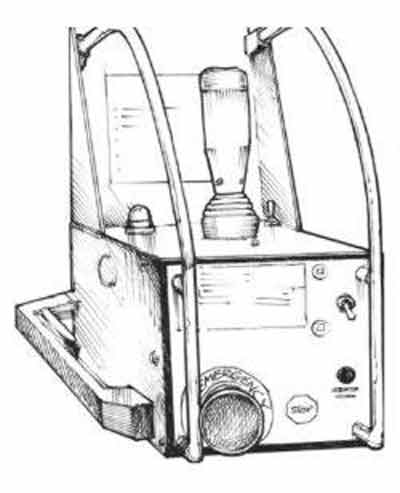 |
|
Figure. Example of guarded controls. Courtesy of Workers’ Compensation Board of British Columbia, Richmond, B.C., Canada. WorkSafeBC.comexternal icon
|
